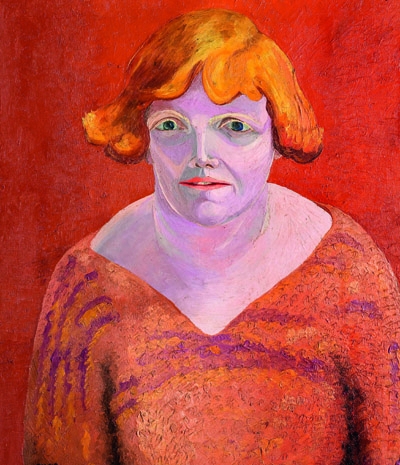Christopher Wood (1901–30), billed as the great white hope of British Modernism, who perished by his own hand before his full potential could be explored. Friend of Ben Nicholson, with whom he supposedly ‘discovered’ the naïve painter Alfred Wallis in 1928, he was a Europeanised sophisticate who knew Picasso and Cocteau and dabbled in Cubism and Surrealism. He was a talented painter with a penchant for harbour scenes, but, as this fascinating exhibition suggests, his gifts have been exaggerated (no doubt because of his romantic life story), while the achievement of his older contemporary Cedric Morris (1889–1982) has been marginalised and largely ignored. Morris is pigeonholed as a charming if slightly artless flower painter and plantsman, a peripheral figure, whereas Wood is placed at the hub of English avant-garde art. In fact, the reverse is just as true, and the reality lies somewhere in between.
Morris, who had been visiting Cornwall since 1919, knew Wallis before he was recognised by Wood and Nicholson as the radical new direction for British Modernism. What Wood & co. made such a fuss about, Morris absorbed quite naturally. (And it should be noted in passing that the natural painter never makes such good art historical copy as the artist with an agenda.) This exhibition allows us to see for the first time how Morris anticipated Wood, and painted very similar subjects with equal, if not greater, panache. Actually, it’s a thoroughly enjoyable exhibition with an excellent selection of paintings by both artists, and a wall of drawings as an added bonus.
From the very beginning of the display, where the visitor is confronted by a pair of self-portraits, the tone of revisionism is established. Wood’s self-portrait offers him up as a florid-faced youth confronting the world with self-conscious bravado, his red-tipped paintbrush held between his legs like an extension of his masculinity. Morris, by contrast, looks much more soulful and mature, posed against a wooded hillside, very different from Wood’s urban setting of Parisian rooftops. Yet Morris also lived in Paris (before Wood), and there are some of his Parisian café scenes here to prove it, though his landscapes are the real revelation. Consider ‘Landscape at Newlyn’, 1919, reputedly Morris’s first oil painting, and a marvellous piece of pattern-making that makes complete sense of the prevalent flattening of space. Wood wasn’t attempting anything like this until half a dozen years later, and it’s clear that Morris acted unofficially as his mentor. The forgotten friendship, now gloriously rediscovered, speaks principally in Morris’s favour.
At last, standardised art history, which places Wood above Morris as a radical and experimental artist, is firmly challenged in this exhibition. I’m all for questioning received ideas, and just around the corner in Norwich Castle’s permanent collection is a room dominated by the paintings of Alfred Munnings, arch-enemy designate of modern art as taught by Morris at his East Anglian art school. Yet how fresh these look, and how remarkably painterly! Isolate a background section of ‘Gravel Pit in Suffolk’ and you can’t help but notice the vibrant handling and abstract quality of Munnings’s luscious paint.
Munnings is an artist disdained by the art establishment, principally because of his intemperate attacks on Modernism. However, commercial galleries can afford to ignore the fatwas of museum dictators, and Richard Green is currently staging a beautiful and impressive show of Munnings’s paintings (at 147 New Bond Street, W1, until 14 December). Half of these are borrowed from the Munnings Museum in Dedham, Suffolk, his old home, and a lovely place to visit on a summer’s day. Others are borrowed from private collections but some are for sale. This is a show that deserves a great deal of serious attention from curators as well as the art-loving public, all of whom should allow themselves to respond to the artist’s singularly energetic depictive powers and the sheer brio of his painterly attack.
Another artist who has recently been disdained by the art establishment is L.S. Lowry. Lowry is immensely popular with the general public, and it seems that museum curators resent this — and feel that he must somehow be a bad artist because of it. Forty years ago, the great and good of the art world (men of taste and discrimination such as Kenneth Clark and Herbert Read) recognised and celebrated Lowry’s genius. Recently, the Tate has refused (despite popular demand) to hang its Lowrys, so it’s a great victory for us Lowry supporters that the Tate has finally given in to public pressure and is mounting a major Lowry show next year. In advance of this event, two commercial galleries are currently offering very different Lowry exhibitions. At Crane Kalman is a selection of some 40 paintings from the Lowry Estate, most of which have never been seen before, and some of which will perhaps surprise visitors. These are the more Expressionist Lowrys: broadly worked seascapes, phallic rocks, strange-looking individuals or haunted crowds (think Munch and Ensor), as well as some of the private late paintings of a marionette-ish female under various forms of restraint.
This collection of works adds another dimension to Lowry’s reputation, and helps to contradict the simplistic view of him as the artist of factories and matchstick men, a cliché that still needs dispelling. Lowry was an immensely sophisticated painter of psychological depth and penetration, a superb technician with a far greater range of subject and style than is usually acknowledged. A selection of some of his more classic subjects can be seen at MacConnal-Mason Gallery (14 & 17 Duke Street, St James’s, SW1, until 11 December), a fine group of street scenes, industrial landscapes and seaside views. ‘The Steps’ is pure street theatre in a crisply executed setting, ‘Derbyshire’ is a charming oil study for the larger landscape of the same subject, and ‘Council Estate’ is an extraordinarily radical composition (note how Lowry used the shapes of steeple and terrace-ends) comparable to C.R.W. Nevinson’s great ‘Road from Arras to Bapaume’. It’s time to rethink preconceptions.






Comments